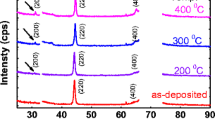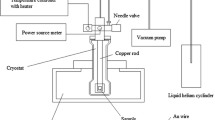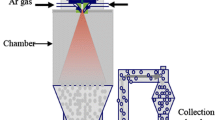Abstract
An investigation was carried out to study the phase transitions in Cu-Ge thin films (80–200 nm in thickness) containing 0, 5, 15, 20, 25, 30, 35, 40, 45 and 50 at% Ge, and the corresponding effects on electrical resistivity. For these films, the phase transitions were found to follow the sequence: α-phase (disordered face centred cubic, fcc, solid solution); 5 at% Ge → ζ-phase (disordered hexagonal close packed, hcp); 15 at% Ge → ζ-phase + ɛ1-phase (ordered orthorhombic, Cu3Ge); 20 at% Ge → ɛ1-phase; 25 at% Ge → (ɛ1-phase + progressively increasing proportions of a disordered Ge-rich solid solution); 30–50 at% Ge. Germanium was found to have no marked effect on grain size of all films studied excluding grain boundaries as electron scattering centres. Transition of the α-phase into the ζ-phase was found to occur in a highly coherent manner, which could be related to the reduced stacking fault energy of Cu by the addition of Ge. Most evidence pointed out that the initial increase in resistivity within the α-phase range was related to hcp scattering centres, which could be associated with a localized high concentration of Ge. At 15 at% Ge, the resistivity reached a maximum value of about 50 μΩ cm associated with the complete transformation of α-phase into the ζ-phase. With continued increase in Ge concentration, the resistivity was found to gradually decrease reaching a minimum value of about 10 μΩ at 25 at% Ge, which was correlated with complete transition of the ζ-phase into the ordered ɛ1-phase (Cu3Ge). It was shown that the superlattice of Cu3Ge could directly be derived from the disordered ζ-phase by minor atom rearrangement on the [0 0 0 1]hcp plane. Even though, minor proportions of a Ge-rich solid solution containing a small concentration of Cu were formed at Ge concentrations above 25 at%, the minimum resistivity of 10 Ωμ cm was maintained as the Ge concentration was increased to 35 at%. Subsequently, the resistivity was increased reaching about 46 μΩ cm at 50 at% Ge.
Similar content being viewed by others
References
T. B. Massalski, in “Physical Metallurgy”, edited by R. W. Cahn and P. Hassen (North Holland, Amsterdam, 1983) p. 153.
C. S. Barrett andT. B., Massalski, “Structure of Metals” (McGraw Hill, New York, 1966) p. 247.
M. O. Aboelfotoh andH. M. Tawancy,J. Appl. Phys. 75 (1994) 2441.
M. O. Aboelfotoh, H. M. Tawancy andL. Krusinelbaum,Appl. Phys. Lett. 63 (1993) 1622.
M. O. Aboelfotoh andL. Krusin-Elbaum,J. Appl. Phys. 70 (1991) 3382.
L. Krusin-Elbaum andM. O. Aboelfotoh,Appl. Phys. Lett. 58 (1991) 1341.
J. C. Hensel, R. T. Tung, J. M. Poate andF. C. Unterwald,Phys. Rev. Lett. 54 (1985) 1840.
J. C. Hensel, R. T. Tung, J. M. Poate andF. C. Unterwald,Appl. Phys. Lett. 44 (1984) 913.
L. Krusin-Elbaum, J. Y. C. Sun andC. Y. Ting,IEEE Trans. Electron Devices ED-34 (1987) 58.
M. O. Aboelfotoh andB. G. Sevensson,Phys. Rev. B44 (1991) 12742.
R. B. Laibowitz andA. N. Boers,Treatise on Mater. Sci. 24 (1982) 285.
J. I. Goldstein, D. B. Willliams andG. Cliff, in “Principles of Analytical Electron Microscopy”, edited by D. C. Joy, A. D. Roming and J. I. Goldstein (Plenum Press, New York, 1986) p. 155.
T. Jossange andJ. P. Hirth,Phil. Mag. 13 (1966) 657.
C. S. Barrett andT. B. Massalski, “Structure of Metals” (McGraw Hill, New York, 1966) p. 358.
P. Hassan, “Physical Metallurgy” (Cambridge University Press, 1978) p. 127.
P. R. Swan, in “Electron Microscopy and Strength of Crystals”, edited by G. Thomas and J. Washburn (Wiley Interscience, New York, 1963) p. 131.
A. Howie andP. R. Swan,Phil. Mag. 6 (1961) 1215.
P. R. Swan andJ. Nutting,J. Inst. Met. 90 (1961) 133.
P. Villars andL. D. Calvert, “Pearson's Handbook of Crystallographic Data for Intermetallic Phases”, Vol. 2 (American Society for Metals, Metals Park, OH, 1985) p. 1948.
T. B. Massalski andB. Cockayane,Acta Metall. 1 (1959) 762.
S. Mahajan, M. L. Green andD. Brasen,Metall. Trans. 8A (1977) 283.
S. Koike, M. Hirabayashi andT. Suzuki,Phil. Mag. 45 (1982) 261.
T. Suzuki, M. Hasegawa andM. Hirabayashi,J. Phys. F6 (1976) 779.
M. Hansen “Binary Alloy Phase Diagrams” (American Society for Metals, Metals Park, OH, 1986) p. 919.
Author information
Authors and Affiliations
Rights and permissions
About this article
Cite this article
Tawancy, H.M., Aboelfotoh, M.O. Effect of phase transitions in copper-germanium thin film alloys on their electrical resistivity. J Mater Sci 30, 6053–6064 (1995). https://doi.org/10.1007/BF01151527
Received:
Accepted:
Issue Date:
DOI: https://doi.org/10.1007/BF01151527




